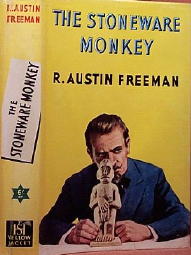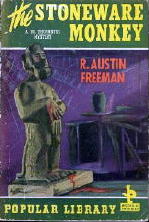Sat 14 Jul 2007
Review by Mary Reed: R. AUSTIN FREEMAN – The Stoneware Monkey.
Posted by Steve under ReviewsNo Comments
R. AUSTIN FREEMAN – The Stoneware Monkey.
Hodder & Stoughton, hardcover, 1938. Dodd Mead & Co, hardcover, 1939. Paperback reprints: Popular Library #11, 1943. Dover, with The Penrose Mystery, 1973.

Dr James Oldfield is doing a stint as a locum-tenems in the small country town of Newingstead. Biking back after a professional call, he stops on a country road to smoke a pipe and enjoy the pleasant evening air. Investigating a cry for help from nearby Clay Wood, he discovers Constable Alfred Murray dying from a fatal blow dealt with his own truncheon.
Constable Murray had been chasing whoever stole a packet of diamonds worth some 10,000 pounds from Arthur Kempster. A dealer in London, Kempster lives locally and carelessly left the gems unattended, allowing the thief to pop in a window, take them, and scarper. Kempster runs after the thief, engaging Constable Murray in the pursuit. Thief and constable outpace Kempster so there is no witness to the murderous assault, and the criminal escapes by stealing Dr Oldfield’s bike.
The scene then shifts to Dr Oldfield’s practice in Marylebone, London. One of his patients is Peter Gannet, who lives at 12 Jacob Street — a thoroughfare with more than its ration of crime! Gannet shares the studio behind his house with his wife’s second cousin, Frederick Boles, a maker of jewelry. Gannet is a potter, and among creations displayed on his bedroom mantelpiece is the titular statuette. Gannet’s works do not impress Dr Oldfield much, for he describes them as “singularly uncouth and barbaric”, exhibiting “childish crudity of execution”. Be that as it may, Gannet’s illness defies all the treatments prescribed, and so Dr Oldfield, a former pupil of Dr Thorndyke, Freeman’s primary series character, decides to consult his old teacher about the case.
They make a startling discovery, pointing to an attempt to murder Gannet. Is the culprit Mrs Letitia Gannet, who does not appear to get along with her husband? Or is it Boles, suspected of being over familiar with Mrs Gannet? Might it be the Gannets’ servant, or perhaps even an unknown outside party? Nothing is established and things return to normal in the household but after Mrs Gannet returns from a holiday she finds her husband is missing and Boles has disappeared. Then a startling discovery is made and Thorndyke is called upon to solve the mystery.

My verdict: Although I guessed whodunnit and why before reaching the closing stages of the book, it was more by intuitive leap rather than Dr Thorndyke’s careful step by step building up of a case, so I missed some of the more subtle clues planted along the way. The novel features perhaps one too many coincidences for my taste, although I got a kick from RAF’s nod to The Jacob Street Mystery. There’s a fair bit of interest in the explanation of the procedure to be followed in bringing a capital case, while the portion devoted to pottery technique may make readers’ eyes glaze, no pun intended, but also forms an important part of the narrative.
All in all, however, I found this one of RAF’s less interesting works, so give it a mark of B minus. Other readers will probably enjoy it more.
Etext: http://gutenberg.net.au/ebooks07/0700811.txt